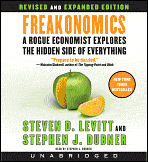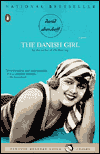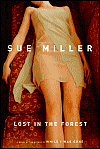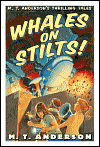Recently Read and Heard...
 Freakonomics by Steven Levitt and Stephen Dubner. In my never ending quest to be up on the latest bestsellers two to three years later or more, I borrowed Freakonomics on CD from the Reading Room recently. Extremely entertaining and thought provoking... I was particularly interested in how they determined teachers were cheating for their students on standardized tests in their desperation to Leave No Child Behind and the explanation of the economics of crack dealing. Did you know that only pays about $3.00 an hour for the dealer on the street? The analysis of baby naming patterns goes on for quite a bit but is fascinating stuff. If you haven't read or heard this yet, it is definitely worth a listen.
Freakonomics by Steven Levitt and Stephen Dubner. In my never ending quest to be up on the latest bestsellers two to three years later or more, I borrowed Freakonomics on CD from the Reading Room recently. Extremely entertaining and thought provoking... I was particularly interested in how they determined teachers were cheating for their students on standardized tests in their desperation to Leave No Child Behind and the explanation of the economics of crack dealing. Did you know that only pays about $3.00 an hour for the dealer on the street? The analysis of baby naming patterns goes on for quite a bit but is fascinating stuff. If you haven't read or heard this yet, it is definitely worth a listen.Lost in the Forest by Sue Miller. This book on CD made me uncomfortable, primarily because the central plot point was the seduction of a 15-year old girl by a 50-year old man. It was very graphic. I was Lost in the Points of View several times also, wondering whose story this was as the focus shifts from Eva, the widowed mother, to Mark, her ex-husband, to Daisy, the grief stricken 15-year old, all lost in one way or another. The Red Riding Hood theme is a little too simplistic to describe the complexities and layers here and some things, like the responsibility of the older man, seem oddly unaddressed.
Whales on Stilts by M. T. Anderson. This book for children is getting a lot of publicity lately and buzz among the book bloggers, but I personally did not care for it. It reminded me very much of the Lemony Snicket books, which I also dislike. I also hate puppets. Please don't turn me in to the children's library police. I guess the point of the forced hilarity in this book is to satirize other children's series (I'm looking at you, Lemony!) but I think it falls flat. I am not, however, twelve.
 The Danish Girl by David Ebershoff. This was September's selection for the Women's Studies Reading Group. I wandered away from the group a couple of years ago because it seemed we were reading a lot of transgendered biography but I recently returned to the fold... only to discover that the next selection was the biography of transgendered artist Einar Wegener. I'm beginning to suspect someone in that group has a secret agenda. However, this was a fascinating story about a man who made a choice to live as a woman, back in the 1930's, and actually had sex reassignment surgery, a rarity at the time. What interested me the most, however, was the flipping of gender roles with his artist wife who remained loyal to him/her throughout the experience. I have always found artistic marriages or partnerships kind of interesting and it often seems that the woman's career becomes secondary (ex. Picasso, Rodin, Pollock) ...perhaps from an inferior talent, perhaps from the subjugation of the relationship, perhaps from the suffocation of living with genius. In this story, the woman artist/wife is a secondary talent and Wegener is more successful. This changes when he becomes a woman. She requests that he dress as a woman to be her temporary model and help her complete a portrait, which launches the whole chain of events wherein he eventually completely transforms into "Lily." Her artwork becomes most sought after, as long as she is painting the beautiful Lily, and Lily/Einar no longer has any interest in painting at all. I think Alanis Morissette would call that ironic.
The Danish Girl by David Ebershoff. This was September's selection for the Women's Studies Reading Group. I wandered away from the group a couple of years ago because it seemed we were reading a lot of transgendered biography but I recently returned to the fold... only to discover that the next selection was the biography of transgendered artist Einar Wegener. I'm beginning to suspect someone in that group has a secret agenda. However, this was a fascinating story about a man who made a choice to live as a woman, back in the 1930's, and actually had sex reassignment surgery, a rarity at the time. What interested me the most, however, was the flipping of gender roles with his artist wife who remained loyal to him/her throughout the experience. I have always found artistic marriages or partnerships kind of interesting and it often seems that the woman's career becomes secondary (ex. Picasso, Rodin, Pollock) ...perhaps from an inferior talent, perhaps from the subjugation of the relationship, perhaps from the suffocation of living with genius. In this story, the woman artist/wife is a secondary talent and Wegener is more successful. This changes when he becomes a woman. She requests that he dress as a woman to be her temporary model and help her complete a portrait, which launches the whole chain of events wherein he eventually completely transforms into "Lily." Her artwork becomes most sought after, as long as she is painting the beautiful Lily, and Lily/Einar no longer has any interest in painting at all. I think Alanis Morissette would call that ironic.
 My Freshman Year: What a Professor Learned by Becoming a Student by Rebekah Nathan. This book was October's selection for the Women's Studies Reading Group and provided some interesting insight into student world. Like Margaret Mead among the Samoans, Nathan lived in the dormitory to observe student life first hand, actually posing as a non-traditional. In my opinion, this made her the "other" despite her good intentions. I found most fascinating the subversion of all of our efforts. For example, within several feet an observer might see the official dormitory bulletin board with advice about responsible alcohol use and personal door decorations depicting students over-indulging. All of the community building exercises seemed rather futile, as students established their own bonds based on high school friendships and majors. Nathan was motivated by her students' perceived lack of motivation and engagement, although I think any education major could have told her that motivation and engagement are directly correlated to perceived utility.
My Freshman Year: What a Professor Learned by Becoming a Student by Rebekah Nathan. This book was October's selection for the Women's Studies Reading Group and provided some interesting insight into student world. Like Margaret Mead among the Samoans, Nathan lived in the dormitory to observe student life first hand, actually posing as a non-traditional. In my opinion, this made her the "other" despite her good intentions. I found most fascinating the subversion of all of our efforts. For example, within several feet an observer might see the official dormitory bulletin board with advice about responsible alcohol use and personal door decorations depicting students over-indulging. All of the community building exercises seemed rather futile, as students established their own bonds based on high school friendships and majors. Nathan was motivated by her students' perceived lack of motivation and engagement, although I think any education major could have told her that motivation and engagement are directly correlated to perceived utility.


0 Comments:
Post a Comment
<< Home